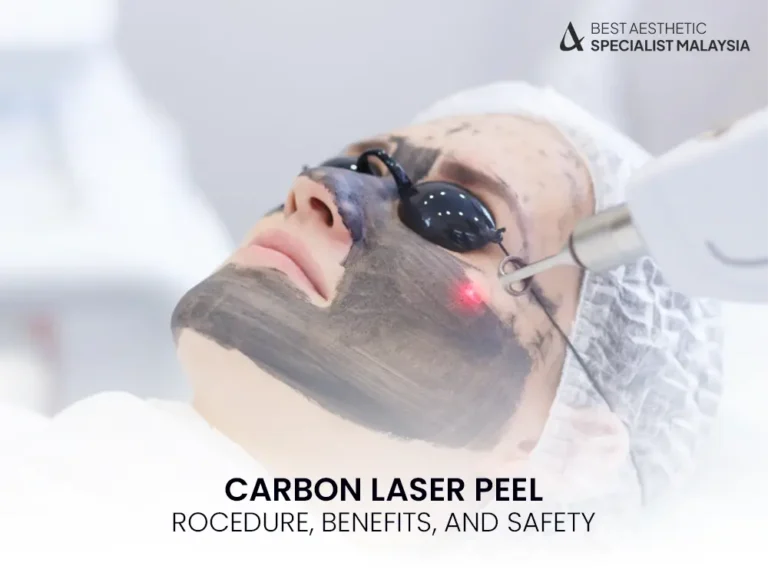Carbon Laser Peel
Carbon Laser Peel, often marketed as the “Hollywood Peel,” is a non-invasive dermatological procedure that utilizes laser energy and a carbon-based lotion to exfoliate, cleanse, and rejuvenate the skin. It is particularly effective for oily skin, enlarged pores, acne, and dull complexion. This advanced treatment is gaining traction not only for its immediate cosmetic benefits but also for its therapeutic potential in treating acne vulgaris and photodamaged skin.
In this article, we explore the scientific and clinical underpinnings of Carbon Laser Peel, detailing its mechanism of action, patient suitability, safety considerations, and post-treatment outcomes.
Mechanism of Action
The Carbon Laser Peel combines topical carbon application with Q-switched Nd:YAG laser technology. The treatment involves two main stages:
Carbon Lotion Application:
A medical-grade liquid carbon solution is applied evenly to the patient’s face. This carbon penetrates pores and binds to oils, dead skin cells, and other impurities.Laser Activation:
The dermatologist uses a Q-switched 1064 nm Nd:YAG laser to target the carbon particles. The laser energy is absorbed by the carbon, causing a photomechanical and photothermal reaction. As the carbon particles explode, they exfoliate the skin and cleanse the pores while simultaneously stimulating dermal collagen production.
Clinical Benefits of Carbon Laser Peel
1. Improvement in Acne and Seborrhea
Multiple studies suggest that Carbon Laser Peel significantly reduces sebum production and Propionibacterium acnes colonization, thereby improving inflammatory and non-inflammatory acne lesions.
2. Reduction of Pore Size
The laser-induced thermal effect tightens the skin and shrinks dilated pores, resulting in a smoother skin texture.
3. Enhanced Skin Tone and Brightness
By removing superficial dead skin cells and impurities, the treatment immediately improves skin radiance and luminosity.
4. Stimulation of Collagen Synthesis
Heat generated during the procedure stimulates fibroblasts to produce new collagen and elastin, contributing to long-term skin firmness and elasticity.
5. Safe for Most Skin Types
Unlike aggressive chemical peels or fractional lasers, Carbon Laser Peel is relatively gentle and suitable for Fitzpatrick skin types I–IV with minimal risk of post-inflammatory hyperpigmentation.
Who Is an Ideal Candidate?
This treatment is particularly beneficial for:
Individuals with oily or acne-prone skin
Patients with dull or uneven complexion
Adults with mild photodamage or superficial wrinkles
Those looking for a non-invasive skin rejuvenation option with minimal downtime
Patients with active skin infections, open wounds, or those on photosensitizing medications should consult with a dermatologist before undergoing the procedure.
Procedure Protocol and Safety Considerations
Pre-treatment Guidelines:
Discontinue use of retinoids, alpha hydroxy acids (AHAs), and beta hydroxy acids (BHAs) 3–5 days prior.
Avoid sun exposure for at least 7 days before treatment.
Procedure Duration:
The entire session takes approximately 30–45 minutes, and no anesthesia is required.
Post-treatment Effects:
Mild erythema or redness that subsides within a few hours
Sensation of warmth or tightness, usually transient
No significant peeling or downtime
Follow-Up Care:
Daily use of broad-spectrum SPF 50 sunscreen is advised.
Use gentle cleansers and non-comedogenic moisturizers for 48–72 hours.
Scientific Validation and Peer-Reviewed Evidence
A clinical trial published in the Journal of Cosmetic and Laser Therapy (2020) showed significant reductions in both sebum levels and lesion count after three sessions spaced 2–3 weeks apart. In another prospective study, patients reported a 90% satisfaction rate and visible improvement in acne and pigmentation with minimal adverse effects.
While further long-term data is warranted, current evidence supports the efficacy and safety of Carbon Laser Peel as a non-ablative, energy-based facial rejuvenation technique.
FAQs About Carbon Laser Peel
1. How many sessions are required for optimal results?
Answer: While visible improvement can occur after a single session, dermatologists often recommend a series of 3–6 treatments spaced 2–4 weeks apart to achieve sustained benefits.
2. Is the treatment painful?
Answer: No, Carbon Laser Peel is generally painless. Patients may experience a mild tingling or snapping sensation, which is well tolerated and does not require anesthesia.
3. Are there any side effects or risks?
Answer: Side effects are rare but may include transient redness, dry patches, or slight irritation. When performed by a qualified practitioner, the risk of burns or hyperpigmentation is minimal.
4. Can it be combined with other treatments?
Answer: Yes, Carbon Laser Peel can be integrated into a comprehensive dermatological regimen and is often combined with microneedling, PRP, or chemical peels for enhanced results.
5. Is it suitable for sensitive skin?
Answer: While generally safe, patients with extremely sensitive or rosacea-prone skin should undergo a patch test and discuss alternative therapies with a dermatologist.
Conclusion
Carbon Laser Peel stands at the intersection of cosmetic dermatology and medical science. By leveraging the principles of laser physics and clinical skincare, it offers a safe, effective, and non-invasive solution for common skin concerns. With proper patient selection and clinical guidance, the procedure can significantly improve skin texture, clarity, and overall health.
Patients considering Carbon Laser Peel should always seek consultation from a board-certified dermatologist or laser specialist to ensure personalized treatment and safe outcomes.


